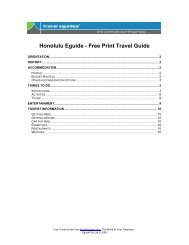Australia Eguide - Travel Guides
Australia Eguide - Travel Guides
Australia Eguide - Travel Guides
Create successful ePaper yourself
Turn your PDF publications into a flip-book with our unique Google optimized e-Paper software.
63<br />
Convict Lumber Yards<br />
This is the oldest surviving example of a convict industrial site. It was in operation<br />
between 1814 and 1846. Moreover, beneath it is an aboriginal site which dates back<br />
several thousands of years.<br />
Foreshore Park ,<br />
This area used to be railway yards, but now has been transformed into a park, with the<br />
old warehouses used as shops and restaurants.<br />
Fort Scratchley<br />
This fort was constructed in 1882, because of fears of a Russian invasion. However, its<br />
first and only action occurred on 7th June 1942, when a Japanese submarine arrived and<br />
fired 24 shots at Newcastle . Fort Scratchley fired two rounds in reply before the<br />
submarine disappeared.The fort is now a Maritime and Military Museum. Beyond the fort<br />
is the Breakwater constructed by convict labour to protect the port.<br />
Newcastle Tram<br />
This is a great way to take in the inner city historical sights, the tram departs from the<br />
railway station hourly and is a 45minute ride.<br />
Bogey Hole,<br />
This is a swimming hole cut in the natural rock, at the order of Commandant Morisset in<br />
1819. Originally it was his private swimming place, but it became a public pool in 1863.<br />
The term ‘Bogey' Hole is evidently derived from the aboriginal word for bathing.<br />
King Edward Park<br />
Given to the city in 1865, but renamed later after the monarch of the time. This park<br />
overlooks the ocean.<br />
Nimbin<br />
Nimbin was the site of healing for the Bundjalung people. In 1973 the Aquaris Festival<br />
brought back the Rainbow Serpent spirit and made Nimbin very much an alternative<br />
culture area. Nimbin museum is dedicated to hippie culture and Aboriginal culture.<br />
Parkes<br />
Parkes developed as a gold town after 1862 and originally called Bushmans. The name<br />
Parkes was from Henry Parkes the governor of New South Wales who visited in 1973. A<br />
main attraction is the Parkes Radio Telescope which transmitted Neil Armstrong’s first<br />
images of his walk on the moon and all told in the film “The Dish”.<br />
Free from <strong>Travel</strong><strong>Eguide</strong>s.com Online <strong>Travel</strong> Information.<br />
©2008 <strong>Eguide</strong> Pty Ltd




